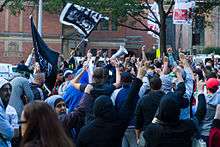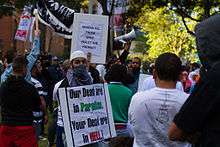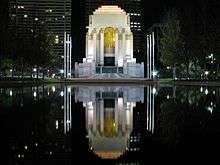Hyde Park, Sydney
| Hyde Park | |
|---|---|
|
A fig-lined avenue in Hyde Park | |
| Location | Central business district |
| Nearest city | Sydney, New South Wales |
| Coordinates | 33°52′24″S 151°12′41″E / 33.873333°S 151.211389°ECoordinates: 33°52′24″S 151°12′41″E / 33.873333°S 151.211389°E |
| Area | 16.2 hectares (40 acres) |
| Created | 3 May 1878[1] |
| Operated by | Sydney City Council |
| Open | 24 hours |
| Status | Open all year |
| Public transit access | Museum station and St James station |
Hyde Park, the oldest public parkland in Australia,[1] is a 16.2-hectare (40-acre) park in the central business district of Sydney, New South Wales. Hyde Park is on the eastern side of the Sydney city centre. It is the southernmost of a chain of parkland that extends north to the shore of Sydney Harbour via The Domain and Sydney's Royal Botanic Gardens. Hyde Park is approximately rectangular in shape, being squared at the southern end and rounded at the northern end. It is bordered on the west by Elizabeth Street, on the east by College Street, on the north by St. James Road and Prince Albert Road and on the south by Liverpool Street.[1]
Around the park's boundaries lie the Supreme Court of New South Wales, St. James Church, Hyde Park Barracks and Sydney Hospital to the north, St Mary's Cathedral, the Australian Museum and Sydney Grammar School to the east, the Downing Centre to the south, the David Jones Limited flagship store and the CBD to the west. It is divided in two by the east-west running Park Street. Hyde Park contains well-kept gardens and approximately 580 trees; a mixture of Hills Figs,[2] palms, and other varieties. It is famed for its magnificent fig tree lined avenues. Sandringham Gardens sit on the eastern side of the park, close to the intersection of Park Street and College Street.
History

Hyde Park was named after the original Hyde Park in London. The park is pock marked with drain lids, many of which lead down to Busby's Bore, the first large-scale attempt at a water source system after backing-up the Tank Stream, the Sydney colony's primary water source. Busby's Bore was built between 1827 and 1837 using convict labour and fresh water from Lachlan Swamp (later known as Centennial Park) to the city.[3]
From the very early days of the colony, the open area to the south east of the settlement was a favorite place for sport and recreation. It was known variously as 'The Common', the 'Exercising Ground', the 'Cricket Ground' and the 'Race Course. On 13 October 1810, Governor Macquarie separated the area from the Domain to the north, named it Hyde Park and dedicated it for the "recreation and amusement of the inhabitants of the town and a field of exercises for the troops". He kept the Domain for his own exclusive use.[3]
Many sports were played at Hyde Park, including cricket, rugby, horse racing, quoits and hurling; however, sports people using Hyde Park had to share it with both the military, who trained on it and practised drill work, the public, who cut paths across the playing fields, stray dogs, cattle, goats, sheep and other animals, as well as sports people, whose activities sometimes clashed. The quoit players, in particular, used an area close to the cricket pitch and often damaged it.[3]
In 2005 a number of disease-affected trees were discovered and felled.[4] Following investigations a significant proportion of the trees were found to be infected with three different fungi. In 2006, a Tree Management Plan recommended the removal of about 230 diseased trees, to be progressively replaced over time.[1]
Sporting activities
Horse racing

Seven Arab horses taken on board the First Fleet at the Cape Colony (now South Africa) were the first horses to be brought to Australia. The first thoroughbred to be brought to Australia was Rockingham in 1799. By 1800 there were 200 horses in the colony which grew to 1100 by 1810. A race ground on the Hawkesbury River near Richmond was probably Australia's first racecourse being used as early as 1806. Match races were run there as part of a holiday at Parramatta in April 1810. Only two days after Governor Macquarie dedicated Hyde Park for 'recreation and amusement' it became the site of Australia's first official horse race meeting organised on 15, 17 and 19 October 1810 by the officers of the 73rd Regiment (Macquarie's regiment). The meetings to devise the rules and organise the event were held in the officers' mess and many of the horses were owned by the officers. The race meeting consisted of a series of heats with weights set depending on the sex and age of a horse. There were also a number of match races between two horses and sweepstake prizes offered. Governor Macquarie himself attended each day of the meeting. This format for race meetings was followed in the colony for the next 50 years. Owners mostly rode their own horses and the courses were marked by flags and posts. Novelty events were often included.
Meetings continued to be held at Hyde Park up until the formation of the Sydney Turf Club in 1825 when they were moved to the 'Bellevue' course. Meetings were also run at Parramatta and Camperdown. The Australian Racing and Jockey Club was formed in 1828 with the encouragement of Governor Darling but the colony could not support two race clubs and both folded in 1831.[5]
Cricket
Although some research indicates that cricket was played before 1803 at the southern end of the Common near where the War Memorial is today, the first confirmed match took place on the Common in 1803. The players were the civilians and officers from the supply ship Calcutta. The cricket ground was laid out in the north-western section of the park (just behind the current entrance to St James railway station) and all major games were played there until 1856.
The first fully recorded match took place in Hyde Park between the 17th and 39th Regiments on 7 May 1832. However, by the 1850s running problems with other users of the Park, the public, the military and players of other sports, ultimately caused cricket matches to be moved to the Domain where unfortunately, similar problems were also encountered.[6]
Boxing
Organised bareknuckle fights were probably common in the early colony and officers of the NSW Corps were known to have arranged fights between convicts. The first recorded fight took place on the road to Botany about half a mile from the Racecourse in 1814. This would put it near the current location of the War Memorial. As if the boxing bout was not enough, the combatants, John Berringer (also known as John Parton) and Charles Sefton, were first required to run a mile. Both Berrenger and Sefton has been sentenced to death in Britain but had their sentences commuted to transportation to NSW. The fight lasted 56 rounds and was won by Berringer.
Rugby
On 17 June 1865 the first known rugby match to be played in Australia took place in Hyde Park between members of Australia's first rugby club, the Sydney Football Club, which had been established that month. In the July that year, the Sydney Club played the Australian Club in Hyde Park, in the first inter-club game.
In 1856, Hyde Park was turned into public gardens and sporting activity all but ceased. Cricket and football clubs had to find other places to play. Cricket was played at the Domain and both sports were also played at Moore Park and the Garrison Ground (now the Sydney Cricket Ground).
Monuments
The centrepiece of Hyde Park is the Archibald Fountain. The fountain was designed by François-Léon Sicard and donated by J.F. Archibald in 1932 in honour of Australia's contribution to World War I in France. Also at the northern end are the Nagoya Gardens featuring a giant outdoor chess set and the entrance to the underground St James railway station.
The fountain features in the notable Australian B-grade horror film Howling III: The Marsupials (1987).
At the park's southern end is the ANZAC War Memorial behind the 'Lake of Reflections' or 'Pool of Remembrance' and the entrances to the Museum railway station. A monument consisting of a 104-millimetre gun from the German light cruiser SMS Emden stands at the south-eastern, Oxford Street entry of the park. It was built as a memorial to the Australian Imperial Force of World War I. Fund raising for a memorial began on 25 April 1916, the first anniversary of the Australian and New Zealand Army Corps (ANZAC) landing at Anzac Cove for the Battle of Gallipoli.[7] It was opened on 24 November 1934 by His Royal Highness Prince Henry, Duke of Gloucester.

Close to the ANZAC Memorial in the southern end of the park is Yininmadyemi - Thou didst let fall, a public artwork that acknowledges the service of Aboriginal and Torres Strait Islander men and women in the Australian Defence Force. The artwork by Indigenous Australian artist Tony Albert was unveiled on 31 March 2015 and was commissioned by the City of Sydney as part of its Eora Journey public art initiative.
The western, or Elizabeth Street side, at the Bathurst Street entrance of the park sits beside the 22 metre Obelisk decorated with Egyptian features. It was erected in 1857 and unveiled by the then Mayor, George Thornton. However, the monument is actually a sewer vent, and soon the joke around town was to call it 'Thornton's Scent Bottle'.[8] Further south from here is another Middle Eastern inspired monument by the Independent Order of Odd Fellows dedicated to the fallen Sydneysiders of the Great War.
In the northeastern sector, of the southern half of the park, there is a monument to Captain James Cook, erected to commemorate Cook's discovery of the east coast of Australia in 1770. The sculptor was Thomas Woolner (17 December 1825 – 7 October 1892) and the statue was cast by Cox & Sons, at its Thames Ditton Foundry, Surrey, England.
2012 Sydney anti-Islam film protests
On 15 September 2012, a protest by Salafi Muslims against an anti-Islam film Innocence of Muslims was held in Sydney, New South Wales. While the protest started peacefully, violent confrontations between police and protesters began when protesters reached the United States Consulate General.[9] The protest started at about midday when approximately 100 people gathered at the Sydney Town Hall before marching along George Street to Martin Place where the US Consulate is located. Conflict between the protesters and the police started when the former tried to enter the US Consulate.[10] The crowd then moved to Hyde Park, where around 300 people had gathered.[11] Further clashes erupted as police used capsicum spray on protesters who at times threw bottles at police.[12] Protesters chanted "Down, down USA"[10] and carried Sunni Islamist flags and signs saying, "Behead all those who insult the prophet", "Our dead are in paradise, your dead are in hell", "Shariah will dominate the world", and "Obama Obama, we love Osama" and threw bottles and objects retrieved from construction sites at police officers. The police responded by spraying capsicum spray into the crowd.[13][14][15][16][17][18][19] Six police officers were injured of which two were hospitalized.[20]
As the crowd started to leave Hyde Park near St James, Public Order and Riot Squad officers equipped with batons and riot shields had already been stationed at the park exit.[21] Protestors continued to throw stones, sticks and bottles at the police. Riot and mounted police pursued protesters down William Street towards Kings Cross.[21] with police chasing after them.[22]

- A protester carries a sign reading "behead all those who insult the prophet"
 Signs carried at the protest
Signs carried at the protest- Police form a line
- The protest group rallies
Images
 Hyde Park, by John Rae (1842)
Hyde Park, by John Rae (1842) The Obelisk (early 1900s)
The Obelisk (early 1900s)- Captain Cook statue by Thomas Woolner
- Archibald Fountain
- Water fountain
 Sandringham Gardens
Sandringham Gardens The Archibald Fountain (1932)
The Archibald Fountain (1932) Archibald Fountain (2012)
Archibald Fountain (2012)- The Obelisk
(2007)  ANZAC War Memorial at night (2007)
ANZAC War Memorial at night (2007) Looking toward Elizabeth Street (2009)
Looking toward Elizabeth Street (2009)
References
- 1 2 3 4 "Hyde Park: Plan of Management and Masterplan" (PDF). Sydney City Council. October 2006. pp. 7–11. Retrieved 7 September 2012.
- ↑ "Hyde Park tree plan". Sydney City Council. 5 November 2012. Retrieved 2 August 2013.
- 1 2 3 "History of Hyde Park". City of Sydney. 29 November 2010. Retrieved 2 August 2013.
- ↑ Dick, Tim; Gibson, Jano (16 September 2005). "Hyde Park figs trees face the chop". The Sydney Morning Herald. Retrieved 14 February 2007.
- ↑ Vamplew, Wray; Moore, Katharine; O'Hara, John; Cashman, Richard; Jobling, Ian, eds. (1997). The Oxford Companion to Australian Sport (2nd ed.). Melbourne: Oxford University Press.
- ↑ Pollard, Jack (1990). Australia: Test Match Grounds. London: Willow Books.
- ↑ "ANZAC Memorial, Sydney", ANZAC Day Commemoration Committee (Qld) Incorporated, 1998.
- ↑ "Thornton's Scent Bottle". Water, Water Everywhere: a Virtual Historical Exhibition. Sydney City Council. Retrieved 14 February 2007.
- ↑ "Violent Sydney protest erupts". The Queensland Times. 2012-09-17. Retrieved 2012-09-30.
- 1 2 Pearson, Nick; Meddows, Dave (15 September 2012). "Muslim protesters clash with police in Sydney". News.ninemsn.com.au. Retrieved 2012-09-16.
- ↑ "Anti-Islam film protests spread to Sydney". Channel News Asia. 2012-09-15.
- ↑ Gridneff, Ilya (15 September 2012). "Police gas Sydney protesters". Sydney Morning Herald.
- ↑ Cooper, Hayden (2012-09-17). "Text messages and terror connections inflame Muslim protests - ABC News (Australian Broadcasting Corporation)". ABC News (Australian Broadcasting Corporation)- Abc.net.au. Retrieved 2012-09-17.
- ↑ Russia Today. "Graphic video: Australia Muslim protest turns violent, police dog bites man". youtube.com.(requires registration or log-in)
- ↑ AFP (2012-09-15). "Anti-Islam film protests spread to Sydney". youtube.com. Retrieved 2012-09-30.
- ↑ "EDITORIAL: Respect absent in needless riot". couriermail.com.au. 17 September 2012.
- ↑ Benson, Simon. "Behead banners belong in dark ages". The Daily Telegraph. Retrieved 17 September 2012.
- ↑ Ritz, Erica. "HUNDREDS RIOT OUTSIDE U.S. CONSULATE IN SYDNEY: 'BEHEAD ALL THOSE WHO INSULT THE PROPHET'". theblaze.com. Retrieved 15 September 2012.
- ↑ Cooper, Hayden (2012-09-18). "Texts show origin of Sydney protest". ABC News. Retrieved 2012-09-30.
- ↑ Bashan, Yoni (16 September 2012). "Arrests made after police officers injured at anti-Islamic film protest in Sydney CBD". Herald Sun.
- 1 2 "Islam video protest in Syd CBD". Sky News Australia. 2012-09-15. Retrieved 2012-09-30.
- ↑ "Protest erupts in Sydney over anti-Islam film". Special Broadcasting Service. Australian Associated Press. 2012-09-15. Retrieved 2012-09-30.
External links
| Wikimedia Commons has media related to Hyde Park, Sydney. |
- Anne-Maree Whitaker (2008). "Hyde Park". Dictionary of Sydney. Retrieved 27 September 2015. [CC-By-SA]
- Mark Dunn (2008). "Hyde Park Racecource". Dictionary of Sydney. Retrieved 27 September 2015. [CC-By-SA]
- YouTube video showing Archibald Fountain and part of Hyde Park
- YouTube video showing giant chess set in Hyde Park
- YouTube video showing Sandringham Gardens

